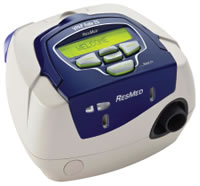Sleep Case Study
Saving Jim
How a bilevel rescue transformed a difficult patient’s compliance
- By Joseph Duffy
- Feb 01, 2011
What happens when you’re faced with a sleep patient that just won’t comply? Sometimes, you have to completely rethink your treatment. That’s exactly what happened with Tracy Kinlaw. Kinlaw is a Respiratory Therapist from Advocate Home Health Services, who also helps as a CPAP liaison at the Arlington Heights Sleep Laboratory. She recently worked with a patient named “Jim,” who had severe trouble staying awake during the day and staying alert at his job.
Jim is a 41-year-old male with Downs Syndrome, and Obsessive Compulsive Disorder. He saw a sleep physician because his family recognized his symptoms of daytime fatigue, diminishing job performance, and weight gain. They were familiar with these signs and symptoms because five years prior, Jim was diagnosed with sleep apnea.
The sleep technicians tried to work with him, but, unfortunately, due to his Downs Syndrome and OCD, he was unable to tolerate Cpap. As a result, the doctor ordered Jim to have a tonsillectomy. The surgery worked to help his sleep apnea for a few years. Now, five years later, his daytime tiredness was back in full force, and the family was very concerned and wanted help.
A Second Look
Jim came into the Sleep Center to be re-evaluated. The physician recommended that he have a polysomnograph. A PSG is an overnight sleep study that records a patient’s sleep patterns, breathing, heart activity, oxygen levels and limb movements during sleep.
The tests and expert opinion concluded that Jim’s sleep apnea returned and he was considered severe, with an AHI (apnea-hypopnea index) of 98. Jim was having shallow breathing or stopped breathing 98 times per hour. At this point the sleep technicians worked with Jim to get him comfortable with the CPAP mask and machine so he would be able to tolerate the CPAP titration study.
During this study Jim would sleep with the CPAP mask and machine and technicians would titrate the levels of pressure to find Jim’s ultimate pressure to keep his airway open and maintain safe oxygen levels. Jim did much better this time and the CPAP titration study was successful. An urgent order was sent to Advocate Home Health Services to set up Jim on a ResMed Auto CPAP set at 16-20cwp.
A New Solution
 The VPAV Auto 25 is a compact bi-level device designed to deliver eff ective therapy as naturally and comfortable as possible. The Auto 25 combines the Autoset algorithm with ResMed’s Easy-Breathe technology to make breathing easier for patients with OSA, noncompliant CPAP users and those who require additional ventilatory support.
The VPAV Auto 25 is a compact bi-level device designed to deliver eff ective therapy as naturally and comfortable as possible. The Auto 25 combines the Autoset algorithm with ResMed’s Easy-Breathe technology to make breathing easier for patients with OSA, noncompliant CPAP users and those who require additional ventilatory support.
Jim had many difficulties becoming compliant with the CPAP therapy. He lives in a group home and has limited help with working with the CPAP. After 60 days on CPAP therapy he was at 5 percent compliance, which meant he wasn’t wearing his machine and wasn’t feeling the relief he should be feeling.
It was decided to change his therapy and do a bi-level rescue. Jim was put on ResMed’s VPAP (variable positive airway pressure) AUTO, which delivers two levels of pressure and tends to be more comfortable for the patient. His settings on the VPAP auto were 20/10cwp with a pressure support of four. This type of therapy is meant for difficult patients that have a hard time tolerating higher pressures on CPAP.
After 60 days on his new bi-level machine, Jim’s compliance skyrocketed to 73percent compliance.
Jim was feeling all the benefits of his VPAP machine. He felt more awake and alert, and his concentration improved at work and at home. Even his weight improved. After treatment Jim started to feel the benefit of more energy, which led him to weight loss. Before treating his sleep apnea with VPAP his BMI was 42.6 and after 60 days on treatment his BMI had dropped to 39.4.
Jim’s story is an example of a true team effort. The sleep laboratory was very involved and worked together with Advocate Home Health to get this patient compliant, with the best quality of life. The patient and family came in for many doctor visits and respiratory therapists from Advocate Home Health went to the group home and worked with family members on many occasions for education on sleep apnea, education of the machine, mask fittings and positive reinforcement.
When Kinlaw first met the patient he was sleepy, tired, and didn’t speak. On their last meeting she claims he was alert, smiling and happy to talk to her. Jim referred to his treatment as “a pain in the butt,” but added that he knows it helps him at work to be awake and help other people.
This article originally appeared in the Respiratory & Sleep Management February 2011 issue of HME Business.
About the Author
Joseph Duffy is a freelance writer and marketing consultant, and a regular contributor to HME Business and DME Pharmacy. He can be reached via e-mail at [email protected].